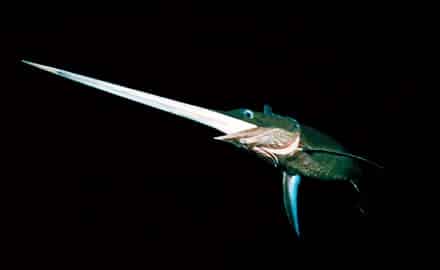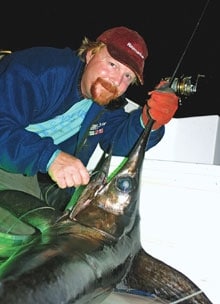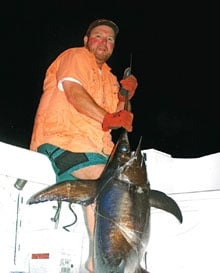
Swordfish feed in the relative shallows of the Gulf of Mexico at night.
Photo: Boyceimage.com
About half past the witching hour, three or four subtle clicks of the reel had us up in a ¿¿ash and staring out into the darkness of the black water. The scene was illuminated by the dim glow of a full moon trying to break its way through a hazy fog. ¿ A few inches of line clicked off the spool. Then a few feet. Then nothing. Captain Peace Marvel pinched the line between his index finger and thumb and eyed the water with a cocked brow. Something was on the line. We didn’t know what.
We were fishing baits 400 feet deep, in well over 3,000 feet of water, off Venice, Louisiana. We had already tangled with a few blackfin tuna and a shark big enough to take the lower unit off an outboard, were it so inclined. Sharks and tuna typically take a bait on the run.
We had four lines out. Two were rigged up with live hardtails, and two with squid. Fellow angler Jeff Pierce and I were locked up like a couple of pointers over a covey of quail.
“If I was a betting man I’d put a lot of money on the chance of this being a broadbill swordfish,” said Marvel, in a whisper.
It was eerily quiet. There was no wind. The water along the continental shelf was black as squid ink. That staggered click from the reel had us spooked.
Suddenly the line came tight, and the reel clicker was on fire.
“Lock and reel! Lock and reel!” yelled Marvel. “She’ll spit the bait! Let’s go!”

| |Lighted rigs help Captain Peace Marvel induce night-feeding broadbills to strike. Photo: Robert Sloan| I stepped up to the gunwale, put the reel into gear and cranked like crazy. The basketball-sized balloon being used as a float on the line zipped across the dark water and disappeared. The rod tip bowed over. I pulled the rod out of the gunwale holder and locked it into my fighting belt.
“That, my friend, is a swordfish,” said Marvel. “Have fun.”
These fish will take you to your knees on stand-up tackle, as I was finding out in a hurry.
“Stay with her,” directed Marvel. “Don’t give her any slack. Short up, short down with the rod. Keep the line coming in.” At first the sword angled to the boat. Then, as if somebody turned a switch, it reversed direction and went south and deep.
I leaned back against the drag and watched as line rolled off the Shimano Tiagra 80 wide.
That night we caught two swords in the 80- to 100-pound class. They weren’t monsters, but they fought like the dickens and made some heart-stopping jumps right at the boat, all the more exciting in the dark. Talk about a night of wild angling, that was it.
Join the Battle
That particular trip had been on the calendar for months. Marvel, with whom I fish a good bit, had been talking about catching swordfish. Though best known for his prowess with yellowfin tuna, Marvel has expanded his horizons to hunt for broadbills, and he’s been very successful, so far. In the past two years he has caught 14 hard-fighting swords. Then one particular day he had a real story to tell. He had just gotten back from a trip with Pierce, a sales manager with the O. Mustad & Son hook company, who had come down from Auburn, New York, to catch a big sword.
They went out to an area that Marvel had scouted. It was along a point off the continental shelf where the water dropped from 400 feet to a depth of over 3,000 feet.
The first night out, Pierce hooked up with a big sword, and the battle lasted three hours, ending at 4:15 a.m.
The swordfish measured 110 inches and weighed 154.9 pounds. Currently the third heaviest landed by a recreational fisherman off Louisiana, Pierce’s swordfish is the first to make the state record books since 1989.
An angler named Tom Dentin caught the Louisiana state-record swordfish, a 310-pounder, in July 1980. My firsthand experience with the species began in 1979, when J.P. Bryan, Jr., caught the Texas state-record swordfish, a fish that weighed 317 pounds and measured 142 inches. I had just come in from a night-fishing trip on the bay when Bryan and friends were backing down to the dock at Port O’Connor, on the middle Texas coast. I saw a big, forked tail sticking out of the cockpit. They pulled back the tarp and there it was -a huge swordfish. It took me 26 years, but I made it to the dance with a midnight swordfishing adventure.
Swordfish along the Gulf Coast don’t get nearly as big as blue marlin. But they will put up a battle like you have never experienced. And Marvel should know, having hooked one conservatively estimated to weigh 350 pounds. He’s got that one on video.
“Over the years lots of anglers have tried to catch swordfish,” says Marvel. “But nobody could really pinpoint them on a regular basis. Most catches are purely accidental. It’s a new frontier off of Louisiana. One that I have figured out.”
There is nothing easy about fishing for and catching a swordfish. It takes place at night and that means most anglers have to totally reverse their fishing schedule -leaving the dock at dusk and returning at dawn. Successful nights mean no sleep.
Swords typically come in relatively shallow to feed at night, then move deep during the daylight hours. The best depths to fish baits at night are between 100 to 400 feet. This is labor-intensive fishing: with baits to be rigged, lights to be worked, lines to be set and balloons to be inflated. The typical drill is to fish with three or four lines. Two will be rigged with live hardtails; the others with food-quality squid.
“I’ll usually fish four lines, unless it’s a busy night,” says Marvel.
“Two will have live baits, and two will have dead baits.”
Catch a dozen or so hardtails on the way out by fishing Sabiki rigs around oil and gas rigs where hardtails are visible on the surface. A ten- to 12-inch hardtail is perfect -they shouldn’t be too small.
Bait Up, Drop Down

| |The author fulfilled a long-time goal with this swordfish catch. Photo: Robert Sloan| It’s critical to work as a team when catching live baits. The person on the bait rod makes a cast and hopefully reels in three or four hardtails. Another crew member unhooks the baits, while still another delivers them to the live well. When it’s done right the baits are only out of the water for about 30 seconds. The less stress the baits go through, the longer they will last. And you want them to be lively throughout the night.
Big squid, 24 to 27 inches long, are a swordfish favorite. With advance notice, local fish dealers can usually provide a box of fresh squid.
“The food-quality squid have a better color,” says Marvel. “They also have a better smell. I think those are two important factors.”
Rigging a squid is easy, but time consuming. Marvel rigs them on a section of 300-pound-test fluorocarbon leader. The tip of the leader is cut at an angle so it will slide through the squid. Thread the leader through the mantle and to the bottom of the squid, then snell a 9/0 to 10/0 Mustad Super Marlin 7761 BLN hook to the leader. Stretch the squid out. At the top of the bait use a needle and waxed thread to tie the squid to the leader. Three to four half hitches should do the trick.
The same type of hook is used to bridle the hardtails. Lights are a must. They attract swords in the darkness of the depths. Marvel attaches a three-inch OmniGlow light ten feet above the bait with a rubber band. He prefers a green or blue light. About 30 feet up from the light you want to add a ten-ounce weight with a rubber band, so the weight will break off when a fish is on. Marvel likes to use a 30-foot section of 300-pound-test fluorocarbon for a leader. The hook is snelled to the leader. The other end of the leader is inserted in the end of the Marvel Spectra Hollow Core line and whip-finished with dental floss to form a wind-on leader. “It’s important to use a line with little stretch that can get a good hook set,” says Marvel. “I usually set my lines at 100, 200, 300 and 400 feet deep. At those depths a good hook set is critical.”
The lines are measured out to precise depths. White balloons are attached to float each bait with a rubber band. When a fish is on, the balloon is reeled up to the rod tip and pops. What’s left can be reeled through the eyes of the rod.
Marvel likes to use a Cape Fear 5080 rod seated with a Shimano Tiagra 80 wide. The reels are spooled with 1,250 yards of 80-pound-test line. The captain uses current -11/2 to two knots is perfect -to keep the lines away from the boat. He’ll also bump-troll, moving the throttles in and out of gear, to keep the lines in position.
“What I’ve found out is that the best sword bite is four days either side of the full moon,” says Marvel. “It’s important to find an area that’s holding plenty of bait. If you don’t have any bait, you won’t have too many swords. I use a Raymarine DSM 250 digital sounder for two very important reasons. One is so I can see bottom structure in over 4,000 feet of water. The other is so I can locate suspended pods of bait like squid.”
Marvel says he doesn’t know exactly what months are the best for targeting swordfish. But he has figured out that March through October have produced so far.
“I’m sure that we can catch them during the winter months, too,” says Marvel. “I’ve just never really fished those months.”
Editor’s Note: Due to the damage caused by Hurricane Katrina, Captain Peace Marvel was planning to move his operation to Port Fouchon, Louisiana, until the facilities in Venice are repaired.
For more information, call (985) 534-2278, or visit www.reelpeace.com.
Stable Stock: Gulf Swordfish
Captain Peace Marvel says that, in his opinion, swordfish numbers are stable along the Gulf Coast, even though longliners are putting a noticeable dent in their population.
“They are commercially overfished. There is no doubt about that,” says Marvel. “The brunt of the commercial harvest takes place off Louisiana and Texas, where they have no protection from longliners. One thing that we do know is that once Florida got rid of longliners, the swordfish numbers exploded.” Marvel serves on the Highly Migratory Pelagics Committee of the Gulf of Mexico Fisheries Management Council.
The limit on swordfish in federal waters along the Gulf Coast is one per person, with a three-per-vessel daily limit. The minimum length is 47 inches from the lower jaw to the tail fork. Boats targeting swordfish need a federal permit, available at www.nmfspermits.com. Regulations may be subject to change.
-R.S.









